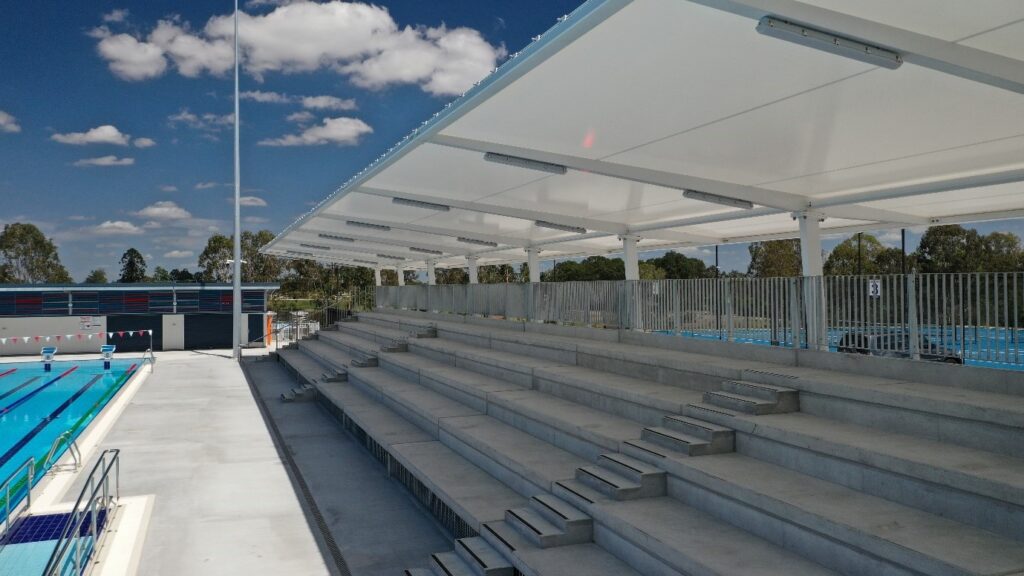YOU ARE HERE:

Waterproof Shade Sail Questions you may have
Jamie Howard In Uncategorized, Shade Sail, Waterproof Shade Structures
Having just had another bout of heavy rain and the La Niña and El Niño declarations about periods of 9 to 12 month, can make it seem as though they are black and white, but the predictions are messy, the natural processes play out a bit differently every time with events occurring every 2 to 7 years.
“The forecasts aren’t perfect. It is not that easy to forecast the progression of La Niña and El Niño events,” according to climate scientist Andrew King from the University of Melbourne.
“We don’t have a really complete understanding of the dynamics of them, which limits our ability to really forecast them very well,” he said.
If you feel you have not had value from your current shade structure with all the wet weather or if you are deciding between a waterproof and regular shade structure, it may be time to upgrade to a waterproof shade solution and this article may help you decide which is best for you. Versatile Structures offers waterproof shade sails that provide reliable protection from the elements, ensuring outdoor comfort regardless of the weather.
A quality shade solution can add a significant functional and aesthetic improvement to an outdoor space especially as there is a wide range colours, shapes, designs to meet the most fastidious check list. Custom Shade sails are an ideal option for creating shade for the following areas:
- Car parks
- Grandstands
- Swimming pools
- Outdoor entertaining areas
- Shopping centres
- Business or residential
- Gardening (Horticultural and Agricultural applications)
Waterproof shade sails need to be installed specifically to avoid pooling of water, which ultimately can lead to failure of the supporting structure and/or the product itself and for this reason are they generally more expensive to install owing to higher quality materials involved as well as much stronger structures that are required to cope with the extra weight and strain placed on the product in high winds.
Are waterproof shade sails worth it?
Both fabric and waterproof shade sails are excellent at offering sun protection, but waterproof sails also offer all-weather protection. Both types of shade sails are available in a range of designer colours and are supported by warranties. The key to deciding whether or not the extra investment in a waterproof shade sail is worth it, lies in how you or your clients and patrons are going to use the area. If you want to protect them from rain, or you are looking for a shade sail for all-weather protection, go with a waterproof shade sail. The next time we are having a 3-day nonstop rain event you will thank yourself for going waterproof.
How long do waterproof shade sails last?
A waterproof shade sail will last longer if you take care of it properly. However, a shade sail is expected to last up to 15 years and can be more, depending on the material and how you maintain it.
Is there a waterproof shade cloth?
Waterproof shade cloth has many uses around the home and in commercial situations. It is a 90% grade shade fabric which has been treated with a UV stabilised resin to form a waterproof barrier. It can be used to create a waterproof layer in many situations including pergolas, vertical blinds, and outdoor areas.
What is the best colour for a shade sail?
Darker shades offer more UV shields than lighter hue shade sails which are best if you are located in a sunny area like the Sunshine Coast in Queensland. If you want to be specific, dark blue colour is the one that absorbs most of the heat while yellow absorbs the least. Our recommendation though is to also take your building aesthetics as well as your brand colours into account when deciding.
How much does it cost to have a shade sail installed?
Shade sails cost around $6,000 to $8,000 each for an average-sized sail. Most residential installations use two or three sails to get good shade coverage and a crisp, modern look. However, for large areas or commercial installations requiring larger sails, you will need to involve an engineer to create a custom solution for your area which can start from $10,000.
How do you keep shade sails from sagging?
Sagging is common on structures that have not been maintained. By retentioning the wire rope on the structure will remove all sagging. Another method to fix the issue is through height variation, where the sails are installed at alternating high and low anchor points. This creates something called a hyperbolic parabola.
Does rain go through shade cloth?
Shade cloth is usually made of loosely woven polyester or even aluminium and can be found in varying densities or degrees of shade from approximately 5% to 95%. All shade cloth is water permeable.
What does GSM mean for shade sails?
GSM stands for grams per square metre. The higher the GSM weight the higher the shade rating, or the tighter the knit, the heavier and stronger the fabric. For example, A GSM of 80 is the sign of low tensile strength (and should be avoided), while a GSM of 200 indicates high tensile strength.
Is 160 GSM waterproof?
Thanks to some technical features and sealed seams, a 160 GSM polyester fabric with double PU (Polyurethane) coating offers good waterproofing and tension. It is certainly a reliable fabric for the entry level range, which performs its rain protection functions well. For a commercial structure we would recommend a much higher GSM of over 500 GSM. We have fabrics that go up to 950 GSM like Precontraint 902 S2
In conclusion
It comes down to what your need and what is going to offer the best return on your investment. However, a waterproof shade structure will be used in rain and sunshine and if you live in or near Brisbane with an average of 178 rainfall days (665 mm of rain) a year then going for a waterproof option makes sense.
Share:
Jamie Howard - Director
Co-founder and Director Jamie has been hands-on in the shade and steel industry since leaving school. With over 15 years’ experience in shade, membrane and steel projects, Jamie is excited about the design opportunities shade structures offer in the commercial and industrial sectors. Jamie’s extensive design skills give him a competitive edge in situations with technical design complexity. He has won two personal industry awards for his designs, alongside many company-won awards.

